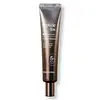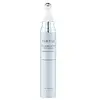What's inside
What's inside
 Key Ingredients
Key Ingredients

 Benefits
Benefits

 Concerns
Concerns

 Ingredients Side-by-side
Ingredients Side-by-side

Water
Skin ConditioningButylene Glycol
HumectantCaprylic/Capric Triglyceride
MaskingGlycerin
HumectantCetyl Alcohol
EmollientPolyglyceryl-3 Methylglucose Distearate
EmulsifyingPalmitic Acid
EmollientStearic Acid
CleansingUrea
BufferingCyclopentasiloxane
EmollientStearyl Alcohol
EmollientC12-15 Alkyl Benzoate
AntimicrobialGlyceryl Stearate
EmollientCarbomer
Emulsion StabilisingTriethanolamine
BufferingMyristyl Alcohol
EmollientDimethicone
EmollientBetaine
HumectantPropanediol
SolventLimnanthes Alba Seed Oil
Skin ConditioningMacadamia Ternifolia Seed Oil
EmollientLauryl Alcohol
EmollientEthylhexylglycerin
Skin ConditioningPanthenol
Skin ConditioningPvp
Emulsion StabilisingAdenosine
Skin ConditioningDisodium EDTA
Arachidic Acid
CleansingSodium Hyaluronate
HumectantAloe Barbadensis Leaf Juice
Skin ConditioningScutellaria Baicalensis Root Extract
AstringentLauric Acid
CleansingMyristic Acid
CleansingOleic Acid
EmollientRosmarinus Officinalis Leaf Extract
AntimicrobialAloe Barbadensis Leaf Extract
EmollientCamellia Sinensis Leaf Extract
AntimicrobialLavandula Angustifolia Extract
Skin ConditioningBioflavonoids
Skin ConditioningCitric Acid
BufferingBrassica Oleracea Italica Extract
AstringentPalmitoyl Tetrapeptide-7
Skin ConditioningAcetyl Hexapeptide-8
HumectantHydrolyzed Collagen
EmollientPalmitoyl Tripeptide-1
Skin ConditioningSh-Oligopeptide-1
Skin ConditioningSh-Oligopeptide-2
Skin ConditioningSh-Polypeptide-1
Skin ConditioningSh-Polypeptide-16
Skin ProtectingSh-Polypeptide-3
Skin ConditioningHydroxyacetophenone
Antioxidant1,2-Hexanediol
Skin ConditioningCaprylyl Glycol
EmollientSodium Benzoate
MaskingPotassium Sorbate
PreservativePhenoxyethanol
PreservativeWater, Butylene Glycol, Caprylic/Capric Triglyceride, Glycerin, Cetyl Alcohol, Polyglyceryl-3 Methylglucose Distearate, Palmitic Acid, Stearic Acid, Urea, Cyclopentasiloxane, Stearyl Alcohol, C12-15 Alkyl Benzoate, Glyceryl Stearate, Carbomer, Triethanolamine, Myristyl Alcohol, Dimethicone, Betaine, Propanediol, Limnanthes Alba Seed Oil, Macadamia Ternifolia Seed Oil, Lauryl Alcohol, Ethylhexylglycerin, Panthenol, Pvp, Adenosine, Disodium EDTA, Arachidic Acid, Sodium Hyaluronate, Aloe Barbadensis Leaf Juice, Scutellaria Baicalensis Root Extract, Lauric Acid, Myristic Acid, Oleic Acid, Rosmarinus Officinalis Leaf Extract, Aloe Barbadensis Leaf Extract, Camellia Sinensis Leaf Extract, Lavandula Angustifolia Extract, Bioflavonoids, Citric Acid, Brassica Oleracea Italica Extract, Palmitoyl Tetrapeptide-7, Acetyl Hexapeptide-8, Hydrolyzed Collagen, Palmitoyl Tripeptide-1, Sh-Oligopeptide-1, Sh-Oligopeptide-2, Sh-Polypeptide-1, Sh-Polypeptide-16, Sh-Polypeptide-3, Hydroxyacetophenone, 1,2-Hexanediol, Caprylyl Glycol, Sodium Benzoate, Potassium Sorbate, Phenoxyethanol
Water
Skin ConditioningGlycerin
HumectantButylene Glycol
HumectantCaprylic/Capric Triglyceride
MaskingDipropylene Glycol
HumectantHydrogenated Poly(C6-14 Olefin)
EmollientNiacinamide
SmoothingMethyl Trimethicone
Skin ConditioningC12-16 Alcohols
EmollientCaprylic/Capric/Myristic/Stearic Triglyceride
EmollientSqualane
EmollientCetearyl Alcohol
EmollientPersea Gratissima Oil
Skin ConditioningPalmitic Acid
EmollientHydrogenated Lecithin
EmulsifyingChlorella Vulgaris Extract
Skin ConditioningGlucose
HumectantStearyl Alcohol
EmollientCetyl Alcohol
EmollientSodium Acrylate/Sodium Acryloyldimethyl Taurate Copolymer
Emulsion StabilisingHydroxyacetophenone
AntioxidantPolyisobutene
Fructooligosaccharides
HumectantFructose
HumectantGlyceryl Stearate
EmollientPanthenol
Skin ConditioningPentaerythrityl Distearate
EmulsifyingSodium Polyacrylate
AbsorbentHydroxyethyl Acrylate/Sodium Acryloyldimethyl Taurate Copolymer
Emulsion StabilisingEthylhexylglycerin
Skin ConditioningDipotassium Glycyrrhizate
HumectantParfum
MaskingXanthan Gum
EmulsifyingCollagen
MoisturisingAdenosine
Skin ConditioningSodium Phytate
Caprylyl/Capryl Glucoside
CleansingSorbitan Oleate
EmulsifyingHydrolyzed Corn Starch
HumectantLeuconostoc/Radish Root Ferment Filtrate
AntimicrobialSucrose
HumectantDextrin
AbsorbentTheobroma Cacao Seed Extract
AntioxidantMyristyl Alcohol
EmollientAscorbic Acid Polypeptide
AntioxidantRosmarinus Officinalis Leaf Water
MaskingLauryl Alcohol
EmollientAspalathus Linearis Leaf Extract
Skin ConditioningHibiscus Sabdariffa Flower Extract
Skin ConditioningMethylpropanediol
SolventTocopherol
AntioxidantCarbomer
Emulsion StabilisingDipeptide Diaminobutyroyl Benzylamide Diacetate
Skin ConditioningPalmitoyl Tripeptide-5
Skin ConditioningPolysorbate 20
EmulsifyingPalmitoyl Tripeptide-1
Skin ConditioningPalmitoyl Tetrapeptide-7
Skin ConditioningWater, Glycerin, Butylene Glycol, Caprylic/Capric Triglyceride, Dipropylene Glycol, Hydrogenated Poly(C6-14 Olefin), Niacinamide, Methyl Trimethicone, C12-16 Alcohols, Caprylic/Capric/Myristic/Stearic Triglyceride, Squalane, Cetearyl Alcohol, Persea Gratissima Oil, Palmitic Acid, Hydrogenated Lecithin, Chlorella Vulgaris Extract, Glucose, Stearyl Alcohol, Cetyl Alcohol, Sodium Acrylate/Sodium Acryloyldimethyl Taurate Copolymer, Hydroxyacetophenone, Polyisobutene, Fructooligosaccharides, Fructose, Glyceryl Stearate, Panthenol, Pentaerythrityl Distearate, Sodium Polyacrylate, Hydroxyethyl Acrylate/Sodium Acryloyldimethyl Taurate Copolymer, Ethylhexylglycerin, Dipotassium Glycyrrhizate, Parfum, Xanthan Gum, Collagen, Adenosine, Sodium Phytate, Caprylyl/Capryl Glucoside, Sorbitan Oleate, Hydrolyzed Corn Starch, Leuconostoc/Radish Root Ferment Filtrate, Sucrose, Dextrin, Theobroma Cacao Seed Extract, Myristyl Alcohol, Ascorbic Acid Polypeptide, Rosmarinus Officinalis Leaf Water, Lauryl Alcohol, Aspalathus Linearis Leaf Extract, Hibiscus Sabdariffa Flower Extract, Methylpropanediol, Tocopherol, Carbomer, Dipeptide Diaminobutyroyl Benzylamide Diacetate, Palmitoyl Tripeptide-5, Polysorbate 20, Palmitoyl Tripeptide-1, Palmitoyl Tetrapeptide-7
 Reviews
Reviews

Ingredients Explained
These ingredients are found in both products.
Ingredients higher up in an ingredient list are typically present in a larger amount.
Adenosine is in every living organism. It is one of four components in nucleic acids that helps store our DNA.
Adenosine has many benefits when used. These benefits include hydrating the skin, smoothing skin, and reducing wrinkles. Once applied, adenosine increases collagen production. It also helps with improving firmness and tissue repair.
Studies have found adenosine may also help with wound healing.
In skincare products, Adenosine is usually derived from yeast.
Learn more about AdenosineButylene Glycol (or BG) is used within cosmetic products for a few different reasons:
Overall, Butylene Glycol is a safe and well-rounded ingredient that works well with other ingredients.
Though this ingredient works well with most skin types, some people with sensitive skin may experience a reaction such as allergic rashes, closed comedones, or itchiness.
Learn more about Butylene GlycolThis ingredient is an emollient, solvent, and texture enhancer. It is considered a skin-softener by helping the skin prevent moisture loss.
It helps thicken a product's formula and makes it easier to spread by dissolving clumping compounds.
Caprylic Triglyceride is made by combining glycerin with coconut oil, forming a clear liquid.
While there is an assumption Caprylic Triglyceride can clog pores due to it being derived from coconut oil, there is no research supporting this.
Learn more about Caprylic/Capric TriglycerideCarbomer is a polymer of acrylic acid. Its main role is to create a gel consistency.
A high amount of carbomer can cause pilling or balling up of products. Don't worry, most products contain 1% or less of carbomer.
Cetyl Alcohol is a fatty alcohol. Fatty Alcohols are most often used as an emollient or to thicken a product.
Its main roles are:
Though it has "alcohol" in the name, it is not related to denatured alcohol or ethyl alcohol.
The FDA allows products labeled "alcohol-free" to have fatty alcohols.
Learn more about Cetyl AlcoholEthylhexylglycerin (we can't pronounce this either) is commonly used as a preservative and skin softener. It is derived from glyceryl.
You might see Ethylhexylglycerin often paired with other preservatives such as phenoxyethanol. Ethylhexylglycerin has been found to increase the effectiveness of these other preservatives.
Glycerin is already naturally found in your skin. It helps moisturize and protect your skin.
A study from 2016 found glycerin to be more effective as a humectant than AHAs and hyaluronic acid.
As a humectant, it helps the skin stay hydrated by pulling moisture to your skin. The low molecular weight of glycerin allows it to pull moisture into the deeper layers of your skin.
Hydrated skin improves your skin barrier; Your skin barrier helps protect against irritants and bacteria.
Glycerin has also been found to have antimicrobial and antiviral properties. Due to these properties, glycerin is often used in wound and burn treatments.
In cosmetics, glycerin is usually derived from plants such as soybean or palm. However, it can also be sourced from animals, such as tallow or animal fat.
This ingredient is organic, colorless, odorless, and non-toxic.
Glycerin is the name for this ingredient in American English. British English uses Glycerol/Glycerine.
Learn more about GlycerinGlyceryl Stearate is a mix of glycerin and stearic acid.
It is used to stabilize the mixing of water and oil ingredients. By preventing these ingredients from separating, it can help elongate shelf life. It can also help thicken the product's texture.
As an emollient, it helps soften skin and supports barrier-replenishing ingredients.
In cosmetics, Glyceryl Stearate is often made from vegetable oils or synthetically produced.
This ingredient may not be fungal-acne safe
Fun fact: The human body also creates Glyceryl Stearate naturally.
Learn more about Glyceryl StearateHydroxyacetophenone is antioxidant with skin conditioning and soothing properties. It also boosts the efficiency of preservatives.
This ingredient is not irritating or sensitizing.
Lauryl Alcohol is a type of fatty alcohol. It is derived from palm kernel oil or coconut oil.
Fatty Alcohols are most often used as an emollient or to thicken a product. They are usually derived from natural fats and oils and therefore do not have the same drying or irritating effect as solvent alcohols.
Myristyl Alcohol is type of fatty alcohol. It is a white, waxy solid and insoluble in water.
As an emollient, it hydrates the skin by trapping moisture in.
Fatty Alcohols are most often used as an emollient or to thicken a product. They are usually derived from natural fats and oils and therefore do not have the same drying or irritating effect as solvent alcohols.
Learn more about Myristyl AlcoholPalmitic Acid is a fatty acid naturally found in our skin and in many plant and animal sources. In cosmetics, it is usually derived from palm oil. It serves many purposes in skincare, acting as a cleanser, emollient, and emulsifier.
As an emollient, palmitic acid helps soften and smooth the skin by preventing water loss. In cleansers, it helps remove oil and dirt while creating foam.
Its emulsifying properties help stabilize products by keeping water and oil-based ingredients from separating.
This may not be suitable for fungal acne-prone skin, as fatty acids like this can sometimes trigger breakouts in sensitive individuals.
Learn more about Palmitic AcidPalmitoyl Tetrapeptide-7 (formerly Palmitoyl Tetrapeptide-3) is a lab-made peptide with anti-inflammatory and skin-repairing benefits. It's made up of four amino acids (glycine, glutamine, proline, and arginine) and palmitic acid (which helps it penetrate skin more effectively).
This ingredient helps reduce inflammation by limiting the production of interleukin-6 (IL-6), a chemical that triggers inflammatory responses, particularly after UV exposure.
Less inflammation = slower collagen breakdown and a longer-lasting, youthful appearance.
Palmitoyl Tetrapeptide-7 also stimulates collagen production and supports a healthier skin barrier.
Over time, this can improve skin firmness, hydration, and reduce the appearance of fine lines. It’s commonly paired with Palmitoyl Tripeptide-1 in the well-known Matrixyl 3000 complex for enhanced anti-aging effects.
This ingredient has been shown to be effective and safe in cosmetic use and you'll typically find it in small amounts (less than 0.01%).
Due to its palmitic acid base, it may not be safe for Malassezia folliculitis.
Read more about other common types of peptides here:
Learn more about Palmitoyl Tetrapeptide-7Palmitoyl Tripeptide-1 is also known as pal-GHK. It is made up of 3 amino acids and palmitic acid, a fatty acid that helps it absorb into skin more easily.
This peptide is as a signal peptide, meaning it tells the skin to produce more collagen. Collagen is the key protein that helps form the skin's structure and keep it plump, firm, and hydrated.
By boosting collagen production, this ingredient supports a stronger skin barrier and helps reduce the appearance of wrinkles.
You'll most likely see this ingredient paired with Palmitoyl Tetrapeptide-7 in the well-known Matrixyl 3000 complex. While results from in-house testing should be viewed cautiously, this peptide duo is among the most studied and widely used in modern skincare.
Due to its palmitic acid base, this ingredient may not be safe for Malassezia folliculitis.
Read more about other common types of peptides here:
Learn more about Palmitoyl Tripeptide-1Panthenol is a common ingredient that helps hydrate and soothe the skin. It is found naturally in our skin and hair.
There are two forms of panthenol: D and L.
D-panthenol is also known as dexpanthenol. Most cosmetics use dexpanthenol or a mixture of D and L-panthenol.
Panthenol is famous due to its ability to go deeper into the skin's layers. Using this ingredient has numerous pros (and no cons):
Like hyaluronic acid, panthenol is a humectant. Humectants are able to bind and hold large amounts of water to keep skin hydrated.
This ingredient works well for wound healing. It works by increasing tissue in the wound and helps close open wounds.
Once oxidized, panthenol converts to pantothenic acid. Panthothenic acid is found in all living cells.
This ingredient is also referred to as pro-vitamin B5.
Learn more about PanthenolStearyl Alcohol is a type of fatty alcohol from stearic acid. It is a white, waxy compound used to emulsify ingredients.
Fatty Alcohols are most often used as an emollient or to thicken a product. Emollients help soothe and hydrate the skin by trapping moisture.
They are usually derived from natural fats and oils and therefore do not have the same drying or irritating effect as solvent alcohols. FDA allows products labeled "alcohol-free" to have fatty alcohols.
Learn more about Stearyl AlcoholWater. It's the most common cosmetic ingredient of all. You'll usually see it at the top of ingredient lists, meaning that it makes up the largest part of the product.
So why is it so popular? Water most often acts as a solvent - this means that it helps dissolve other ingredients into the formulation.
You'll also recognize water as that liquid we all need to stay alive. If you see this, drink a glass of water. Stay hydrated!
Learn more about Water